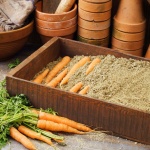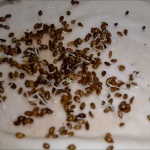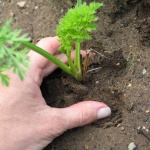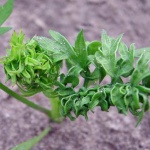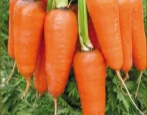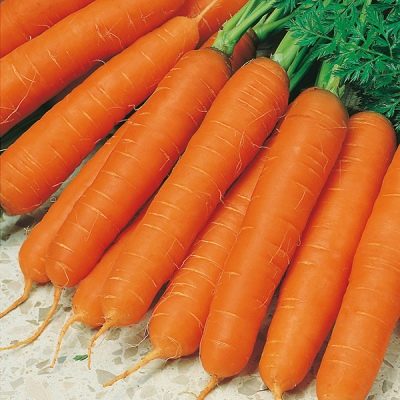
- Authors: Maksimov S.V., Klimenko N.N.
- Year of approval: 2006
- Appointment: for fresh consumption, for canning, for making juice
- Leaf rosette shape: semi-spreading
- Leaves: long, green with shallow to medium dissection
- Weight, g: 120-135
- The form : cylindrical
- Taste qualities: excellent
- Composition : dry matter 11.7-16.4%, total sugar 6.6-9.1%, carotene up to 22.4 mg per 100 g of raw matter
- Ripening terms: mid-season
The autumn king is an unusual carrot variety that is in demand among gardeners. Among the advantages of the culture are the excellent taste characteristics of root crops and the plant's resistance to harsh growing conditions. It is worth considering in more detail the properties and features of planting carrots Autumn King.
Description of the variety
The variety belongs to the group of mid-season plants. Among the main characteristics, there are dense green tops that simplify harvesting, as well as high survival rate even in harsh conditions. Basically, the Autumn King is grown in the Central and Central Black Earth regions of the country.
Characteristics of the appearance of the plant and root crops
The leaf rosette of the variety is of a semi-spreading type. Among the characteristics of root crops are the following:
- conical or cylindrical;
- rounded ends;
- smooth and thin skin of a rich orange hue.
Carrots have a thin core that is difficult to identify. Despite the thin skin, the fruit is suitable for long distance transportation.
Purpose and taste of tubers
Tasters rate the taste of the Autumn King at one of the highest points for its juiciness and sweet aftertaste. The average weight of one root vegetable reaches 120-135 grams; the composition contains useful components and vitamins. The fruits of carrots are used fresh, as well as for the preparation of various dishes and preparations. Freezing root vegetables will help preserve their properties for the entire winter.
Maturation
The first roots appear after 110-115 days after planting carrots in open ground. In the southern regions, the ripening time can be reduced by choosing a warmer and more fertile place.
Yield
The average figure reaches 4-6 kg per square meter. If you carefully approach the care of the plant, it will be possible to collect up to 8.5 kg. If we talk about larger areas, then 170-369 centners are harvested per hectare.
Growing and care
Planting carrots in open ground is carried out by seeds. Pre-inoculum is prepared by carefully selecting samples, which are then soaked in a solution of potassium permanganate. At the same time, fertilization and loosening of the soil are carried out to saturate the soil with the necessary nutrients.
Planting work is performed closer to mid-April or early May, adhering to the following scheme:
- the maximum seeding depth should not exceed 1-2 cm;
- between the seeds should recede up to 5 cm;
- it is necessary to maintain a distance of 15 cm between the rows.
Such a solution will provide a comfortable growth of carrots, which will not be disturbed by anything on the sides. Immediately after planting, the seeds are sprinkled with soil, watered abundantly and covered with transparent material for 2 weeks. During this time, it is recommended to ventilate the homemade greenhouse to prevent the plant from rotting inside.
When the first shoots sprout, you should take care of the carrots. The key points are as follows.
- Watering. Carrots are not particularly demanding for watering. On average, she has enough 1-2 times a week. If the weather is dry, you can increase the amount of liquid introduced into the soil, and with regular rains, you can completely forget about watering.
- Top dressing. The first time fertilization is applied 14 days after planting the crop. Then the plant should be fed every 2-3 weeks to accelerate shoot growth and root formation.
- Loosening and weeding. Two mandatory procedures that are carried out after watering. With their help, it is possible to saturate the soil with oxygen, as well as prevent the spread of diseases and pests in the garden.
In the early stages of carrot growth, gardeners also advise thinning the rows in order to exclude the struggle of the variety for life.
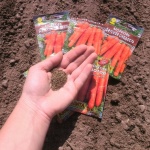
Carrots are one of the most unpretentious crops in terms of growing conditions; they can endure a short drought and a short cold snap. However, to get tasty and large root crops, you should adhere to the basic rules for planting carrots.


Soil requirements
The Autumn King carrots are grown mainly on fertile light soils with a low level of groundwater. When choosing a site, it is worth giving preference to sandy or sandy loam lands, in which the plant will quickly take root due to a small acidity indicator.
Disease and pest resistance
The autumn king is highly resistant to most common pests and diseases. But with poor care, it can still hurt. Often, carrots are attacked by a carrot fly, which can be overcome with the following insecticides:
- "Karate";
- Inta-Vir;
- Volaton.
Also, gardeners are advised to carry out preventive processing of the culture through folk recipes in the form of garlic or onion tinctures.

Carrots grow in almost any garden. There is an opinion that this culture is very resistant to all kinds of diseases and pests, but this is not the case. Without proper care, carrots become susceptible to all kinds of infections and are affected by harmful insects.
Review overview
About carrots Autumn King speak mostly positively. Among the advantages are:
- high productivity;
- unpretentious care;
- fast survival rate.
You can achieve the best yield indicators by following agrotechnical recommendations. Otherwise, the plant will quickly die or lose most of its beneficial properties.

